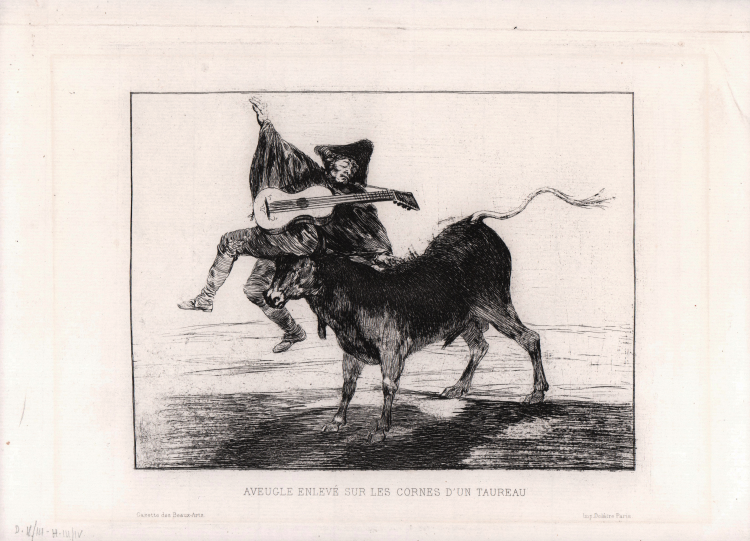



| Reference: | S42111 |
| Author | Francisco de GOYA Y Lucientes |
| Year: | 1804 ca. |
| Measures: | 240 x 175 mm |


| Reference: | S42111 |
| Author | Francisco de GOYA Y Lucientes |
| Year: | 1804 ca. |
| Measures: | 240 x 175 mm |
Etching, aquatint and drypoint with light surface tone, before 1804, lettered on plate with title "AVEUGLE ENLEVÉ SUR LES CORNES D'UN TAUREAU" and publication detail Gazette des Beaux Arts (lower left-hand corner) and Imp. Delâtre Paris (lower right-hand corner).
This etching shows a bull as it charges at a blind man, dressed in a cape and hat and holding a guitar. There are no spatial references in this image to identify where the scene is taking place.
The blind man bears a striking resemblance to the figure in The Blind Guitarist and is also dressed the same. This may suggest that there could have existed more etchings of this same character, or that perhaps Goya had planned to make more, in order to depict further episodes from the blind man's life. Later, during his stay in Bordeaux, Goya returned to the topic of blindness in the work The Blind Singer.
This etching is thought to have been made prior to 1804, since there already existed a copy in the collection of Giovanni Domenico Tiepolo (Venice, 1727-Venice, 1804) at the time of his death that same year.
The title of May God repay you comes from the handwritten note made by Goya on the preparatory drawing. The title of Barbarous Entertainment has been taken from the note written on the proof which was included with the first edition copy of the Bullfighting (Tauromaquia) series which belonged to Ceán Bermúdez and which is now in the British Museum, London.
There is a preparatory drawing for this etching in the Prado Museum.
Bibliografia
Harris 1964, Goya: Engravings and Lithographs (25.III/IV); Delteil, Le Peintre-Graveur Illustré (XIXe et XXe siècles) n. 24 II/III; Gassier, Pierre y Wilson, Juliet, Vie et ouvre de Francisco de Goya, 1970, cat. 772; Santiago, Elena, Catálogo de las estampas de Goya en la Biblioteca Nacional, 1996, cat. 66.
Francisco de GOYA Y Lucientes (Fuente de Todos 1746 - Bordeaux 1828)
|
Spanish painter, draughtsman and printmaker. The most important Spanish artist of the last quarter of the 18th and first quarter of the 19th centuries, he served three generations of Spanish kings. Stylistically his work spans the period from the late Rococo to Romanticism and, at the last, presages Impressionism. During his six active decades he produced some 700 paintings, 900 drawings and almost 300 prints, which reflect his rapidly changing world: the Bourbon Spain of Charles III and the reign of Charles IV, the Enlightenment, the French occupation, the turmoil of the Peninsular War, the despotic reign of Ferdinand VII (and the Inquisition) and Spain’s few years of constitutional government. Appreciation of his prints by non-Spaniards even during his lifetime soon ensured his reputation abroad. Known by 1801 as the ‘Apelles of Spain’, he has been regarded since as a major master of international stature and as the first ‘modern’ artist.
|
Francisco de GOYA Y Lucientes (Fuente de Todos 1746 - Bordeaux 1828)
|
Spanish painter, draughtsman and printmaker. The most important Spanish artist of the last quarter of the 18th and first quarter of the 19th centuries, he served three generations of Spanish kings. Stylistically his work spans the period from the late Rococo to Romanticism and, at the last, presages Impressionism. During his six active decades he produced some 700 paintings, 900 drawings and almost 300 prints, which reflect his rapidly changing world: the Bourbon Spain of Charles III and the reign of Charles IV, the Enlightenment, the French occupation, the turmoil of the Peninsular War, the despotic reign of Ferdinand VII (and the Inquisition) and Spain’s few years of constitutional government. Appreciation of his prints by non-Spaniards even during his lifetime soon ensured his reputation abroad. Known by 1801 as the ‘Apelles of Spain’, he has been regarded since as a major master of international stature and as the first ‘modern’ artist.
|